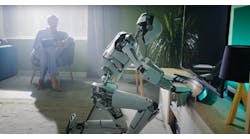I was chatting with an experienced controls engineer who was configuring multiple, distributed fieldbus nodes throughout an advanced automation cell. I asked him what he thought about the distributed I/O, and his simple reply said it all: "Why can't it be as easy as plugging in a mouse to a computer?"
Sorry, but automation manufacturers don't play that way. They will even say, if an existing node fails, just plug in a new one, and it will self-configure. Well, it may be that simple, but I assure you it doesn't always work like plugging in a mouse.
All those flashing green lights don't necessarily mean everything is working. It is often a complex process to get all the devices working together, especially when integrating devices from different manufacturers.
Try adding a node of Ethernet/IP fieldbus. Easy, right? Often, sometimes except, for example, when it won't take a fixed IP address per the design requirement, or when there are firmware issues that only a call to the vendor can identify and fix, and, finally, when no one knows why the new device won't work, be sure to cycle power to the managed switch and wait about a minute. But, remember, it's not consistent. Often the I/O needs to be configured more than once because, sometimes, the configuration is lost when the power is cycled. That doesn't happen with a mouse ever.
Despite these examples and the many others out there, I have no doubt that automation will be much easier in the future, and after chatting with Rebecca Markel, director of marketing at Ready Robotics (www.ready-robotics.com), I'm even more sure.
She noted how her seven-year-old son had quickly programmed a robot to pick and place a part using Ready Robotics’ software. Let's make that the test for defining easier automation.
I wanted to know more, so I talked with Benjamin Gibbs, CEO at Ready Robotics, provider of an easy-to-use operating system for industrial robots.
Gibbs says, "Ready Robotics created a hardware abstraction layer that lets you program robots from different OEMs, as well as peripherals and sensors all through the same interface."
Sign me up for several reasons. "It's appealing to end-user factories, allowing them to more effectively leverage robotic systems without the need to have highly trained robotics and PLC programmers on staff," says Gibbs. "It's also useful to integrators and machine builders because, as end users are empowered to support the robotic systems, you no longer have to have staff supporting debugs or reprogramming when production parts change over. It lets them focus on new business instead."
The easy way is often better. "You can also increase your job velocity," continues Gibbs. "More projects and faster because you are no longer spending as much time as you were previously on the programming side of it. Make it easier for the end user to support, and democratize access to the programming."
Ready Robotics spun out of Johns Hopkins University in Baltimore, Maryland, in late 2015 based on research done by the co-founder and CTO, Kelleher Guerin. "The research revolved around creating a hardware and software architecture that truly enables cross-platform plug-and-play capability," says Gibbs. "Much in the same way when today you just plug your mouse into a computer and the operating system automatically integrates all the drives and in a couple seconds you are up and running using the mouse. We need to reach the same point in robotics, and then we can really unlock this space and help to create a future of ubiquitous robotics."
Easy-to-use and ever-present robotics is music to my ears.
Having spent many years designing and programming robotics systems, I'm realistic here. The technology is not to the point of getting a Fanuc or Universal Robots robot running as simply as plugging in a mouse yet. But that's the goal.
"There have been 40 years of capabilities development in the robotic automation space, and we are a young company," says Gibbs. "We are not at the point where we can do everything that you could expect to do on the leading robotic platforms and create a full-blown custom cell. However, we are always adding features to our software. And currently, through our Forge operating system, you can easily create pick-and-place routines to control robot arms, peripherals and end-of-arm tooling, such as electrically and pneumatically actuated grippers, and monitor and control discrete and safety I/O."
Ready Robotic's Forge software can control a wide range of off-the-shelf robot hardware. It's focused on creating a plug-and-play platform. It also allows existing hardware capabilities to be added into this platform and integrated in a relatively short amount of time.
There is still a need to configure the robot through its time-tested interface, for example, safe spaces or zones, but upgrades are well-tested. "Our overall philosophy, because we are serving an industrial manufacturing space, is we are all about stability and reliability,” says Gibbs. "We don't want to roll out a new feature unless we are certain its implementation will only help the uptime of the system."
Let's keep making automation easier. Ready Robotics is currently rolling out support for fieldbus protocols such as Ethernet/IP and Modbus. Maybe just plug it in.






